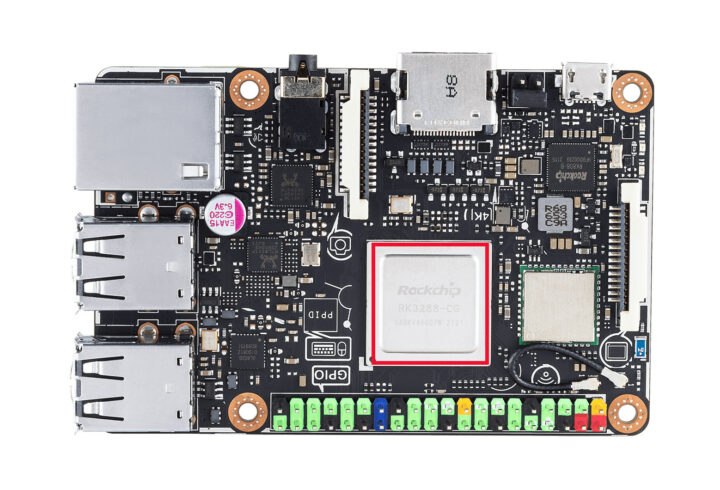ASUS Tinker Board S R2.0 is a revision of the original Tinker Board S board launched in 2018 with a 16GB eMMC flash. The R2.0 model relies on Rockchip RK3288-CG W quad-core Cortex-A17 processor and gets an upgrade to Bluetooth 4.2 from Bluetooth 4.0.
The rest of the specifications remain the same with 2GB DDR3, HDMI 2.0 and MIPI DSI video interface, a MIPI CSI camera interface, a 3.5mm audio jack, Gigabit Ethernet, a WiFi 4 and Bluetooth 4.x module, four USB 2.0 host ports, and a 40-pin color-coded Raspberry Pi compatible header.
 Tinker Board S R2.0 specifications:
Tinker Board S R2.0 specifications:
- SoC – Rockchip RK3288-CG.W quad-core ARM Cortex A17 processor up to 1.8 GHz with Mali-T764 GPU @ up to 600 MHz supporting OpenGL ES 1.1/2.0 /3.0, and OpenCL 1.1
- System Memory – 2GB dual-channel DDR3
- Storage – 16GB eMMC flash + microSD slot
- Video output & Display I/F
- 1x HDMI 2.0 up to 3840×2160 @ 30 Hz with HDMI CEC
- 1x 15-pin MIPI DSI supporting HD resolution
- Audio – 1x 3.5mm audio jack with plug-in detection and auto-switch; Realtek ALC4040 HD codec with 192KHz/24-bit audio
- Camera I/F – 1x 15-pin MIPI CSI connector
- Connectivity – Gigabit Ethernet, 802.11 b/g/n WiFi, Bluetooth 4.2 + EDR
- USB – 4x USB 2.0 host ports, 1x micro USB port (for power)
- Expansion Headers
- 40-pin Raspberry Pi compatible header with up to 28x GPIOs, 2x SPI, 2x I2C, 4x UART, 2x PWM, 1x PCM/I2S, 5V, 3.3V, and GND
- 2-pin contact point with 1x PWM signal, 1x S/PDIF signal
- 2-pin power-on-header
- Misc – Button, unpopulated fan header
- Power Supply – 5V/2-3A via micro USB port with support for low voltage detection
- Dimensions – 85.6 x 54 cm
- Weight – 55 grams
The Tinker Board S R2.0 and Tinker Board R2.0 (no eMMC flash) single board computers support the Debian-based TinkerOS sand Android 12, but I must have missed some changes, as some of the newer OS images are provided only for the R2.0 models unless it’s just for the different wireless module., or the original Tinker Board SBCs have been phased out.
It’s unclear when ASUS introduced the new R2.0 SBCs, but they are already for sale on various websites as we’ll explain below, and I can see the Rockchip RK3288-GC W was added to the datasheet in May 2018. I’ve never heard about it, but it looks like it supports higher CPU (1.8 GHz) and GPU (600 MHz) frequencies compared to the earlier RK3288 introduced in 2024, or at least does so in a more stable manner.
I can also see the RK3288-CG processor, but it’s unclear how it differs from the RK3288-CG W, as the only difference in the datasheet is the way the chips are marked: with a different die lot.
The Tinker Board S R2.0 can be purchased on Amazon, eBay, and various distributors, but the prices I’m seeing ($135+) do not really make it attractive, even at a time of relative supply shortage of Raspberry Pi 4 SBCs. Additional information may be found on the product page.

Jean-Luc started CNX Software in 2010 as a part-time endeavor, before quitting his job as a software engineering manager, and starting to write daily news, and reviews full time later in 2011.
Support CNX Software! Donate via cryptocurrencies, become a Patron on Patreon, or purchase goods on Amazon or Aliexpress







